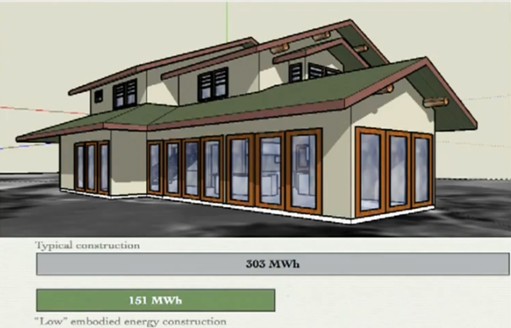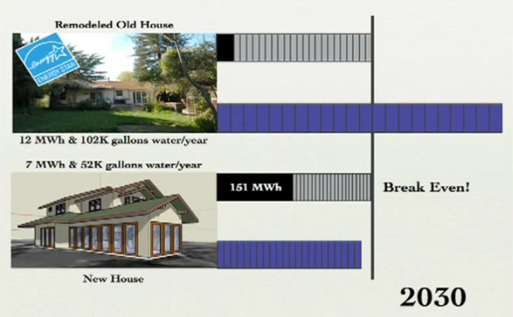Ever feel like you’re being watched by the Green Police? Have a loved-one who thinks that tossing a newspaper in the trash is the equivalent of clubbing a baby seal? Tired of transparent marketing campaigns for products with dubious environmental benefits? You’re certainly not alone.
In this video from TED Talks, Catherine Mohr rightly calls out the insanity of nitpicking over every paper towel or coat of paint, and identifies the real elephant in the room: embodied energy. Embodied energy is the total amount of energy necessary for an entire product lifecycle, including everything from transportation to installation to decomposition. When used as a metric to evaluate sustainable construction construction practices, it can reveal the real opportunities for substantial savings over conventional methods. Not surprisingly, off-the-shelf and post-construction products yield little savings. Instead, the real meat and potatoes savings come from floors, doors, windows and insulation.

On her personal house, Ms. Mohr uses some interesting techniques, including straw bale walls which she claims have zero embodied energy. She also resorts to FSC-certified wood not only for the framing of the house, but also for the windows. This represents a significant savings over aluminum framed windows.
In principle, I’m a fan of what Ms. Mohr has done with her house. That she opted to use straw bale techniques endears her to my heart. However, I find the demolition of the existing house a little unsettling. The tear-down was likely required to pour the concrete slab flooring for passive solar heating, however one wonders the original building could have been retained. Most of us are not self-proclaimed “organic food eating, carbon footprint minimizing, robotic surgery geek[s]” and will not spend an exorbitant amount of time, effort, and money calculating the embodied energy trade-offs associated with the construction of our dream home. If it comes time to rip down the old house, I’m going in with a sledgehammer and a crowbar (read: boys with toys), not a material salvage company. You can kiss that embodied energy savings goodbye.

With a break-even point after initial upgrades nearly 20 years out, and additional improvements a near certainty along the way, is new construction necessarily the most efficient way for the average homeowner to go green? Also, wouldn’t Ms. Mohr be better off ditching the house altogether for a downtown condo where she could cut her annual embodied in half by living car-free (ignoring for a second that she seems to fly for a living)?
Perhaps I’m being too critical. It’s easy to deride those that go out on a limb for a cause. What do you think? Is greening a single-family house a futile venture or a way for every household to make a difference? Should they build off of what’s there, or start anew?
Via Worldchanging
Thayer-D
You make some good points, but I’m not sure she’s responsible to have the absolutely smallest carbon foot print possible since she also wanted a new house and not necessarily a condo life style. To build on your point though, the Atlantic magazine had a great article arguing that NYC was the greenest of all habitats in terms of carbon foot print per person, a big woop woop for urban living.
Another green metric that get’s scant attention but seems relevant here is how likeable a building is. It sounds awfully superficial and is definatley hard to quantify, but has real consequences in terms of what gets torn down. If one builds buildings that people actually like, there’s a better chance all it’s embodied energy won’t get wasted. If one look at the empirical evidence based on what buildings are preserved, it would lead one to assume traditional buildings are greener than modernist buildings. Not to start a battle of the styles argument, but when looking at most European and progressively, American cities, inner city neighborhoods with traditional buildings seem to be the greenest of all. Just a thought.